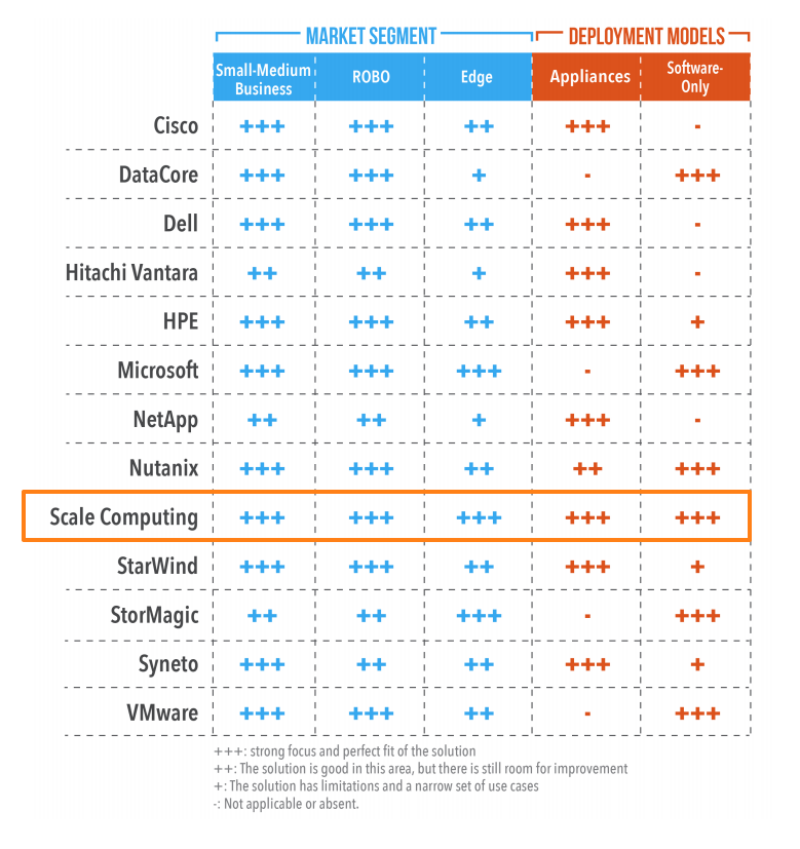Every year, aging IT infrastructure forces companies to deal with unavoidable downtime and data loss. And at an estimated $5,600 per minute, downtime costs easily run into the hundreds of millions if not billions of dollars a year across the globe. While there are temporary fixes to reduce downtime, at some point it will be time to upgrade your entire infrastructure—but how? In this blog, we highlight new research from GigaOm that helps businesses evaluate hyperconverged infrastructure (HCI) solutions so they can build faster, more resilient, and more secure systems to manage their computer, storage, and backup needs from any location.
HCI Differences for Enterprise vs. SME
In the GigaOm 2021 Radar Report for Hyperconverged Infrastructure, analyst Enrico Signoretti highlights the growing divide between HCI solutions for enterprise companies with a few, large locations compared to companies with smaller, more numerous locations. Signoretti makes the case that small and medium size businesses generally don’t need the features and functionality that a company like VMware offers—instead they need flexible, reliable, easy-to-use and affordable solutions that can run unattended at the edge at dozens, hundreds, or even thousands of remote locations.
Given the distinct needs for edge computing, Signoretti explains that the core differences for Enterprise and SMEs are the minimum cluster size (edge computing generally requires very small clusters with just two or three nodes) and tools needed to manage thousands of sites running business-critical applications. These elements include monitoring, automation, data protection, and disaster recovery.
Criteria for Evaluating Hyperconverged Infrastructure Vendors
Evaluating HCI vendors is difficult given the number of companies in the market, as well as the broad range of features and functionality. GigaOm makes this process easier by dividing the criteria into two main groups: one group for features and functionality (Key Criteria), and another group for ease of use and ROI (Evaluation Metrics).
The 6 Key Criteria are:
- Edge-Core Integration: Does the solution enable most core characteristics at the edge?
- Analytics: Are you able to see real-time and historical analytics for compute, storage, and backups?
- Extended Data Storage: Is data storage built in or an add on, and are there different tiers?
- Kubernetes Support: What sort of Kubernetes support options do the vendors offer?
- Automation/Orchestration: Can compute be managed automatically so VMs don’t need to be manually switched between nodes?
- Data Protection: How do each of the vendors ensure your data is protected from threats like ransomware? Do they offer remote data protection solutions?
The 5 Evaluation Metrics are:
- Scalability: How easy it is to add nodes and clusters as your VM demand grows? Can they support thousands of remote sites?
- Flexibility: What kind of storage options are available?
- Efficiency: How many nodes, RAM, and storage are required?
- Ease of Use: How intuitive is the user interface? How easy is it to set up and deploy a cluster, even for non-technical employees?
- TCO and ROI: What is the initial cost of set-up AND the expected long-term maintenance and support costs? Will your investment in a new IT infrastructure solution be worth the costs?
This year, we’re proud to be recognized by GigaOm as a Leader in HCI for SMEs. Signoretti had this to say about our solutions:
When it comes to edge computing deployments, Scale Computing offers one of the most cost-effective solutions on the market, the Scale Computing HE150, based on Intel NUCs compute nodes connected to a clever networking solution on the back end that doesn’t require external switches. This brings the cost and the number of components down to a bare minimum, making it ideal for unattended remote sites.
Ease of deployment and use are other areas in which Scale Computing has invested heavily. New clusters can be installed in minutes and day-to-day operations are simplified, thanks to clean, well-designed dashboards. And the latest hardware appliances have improved VDI support, due to GPU support.
If you are in the process of evaluating HCI vendors, download your complimentary copy of the full 2021 GigaOm Radar Report for Hyperconverged Infrastructure: Small-to-Medium Enterprise and Edge.

